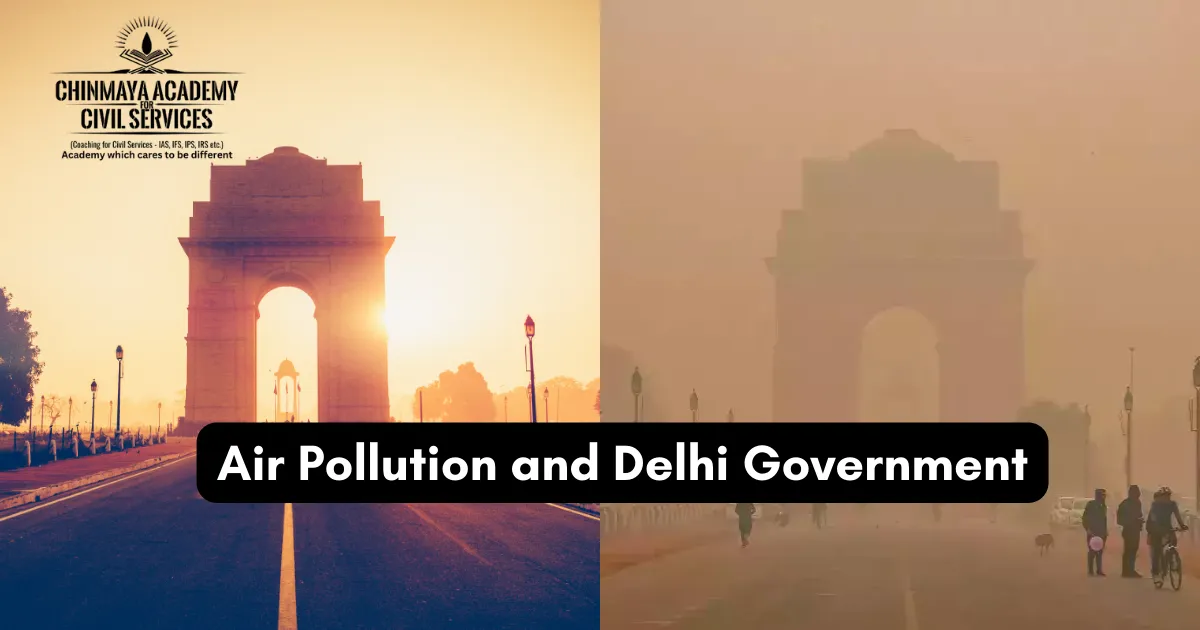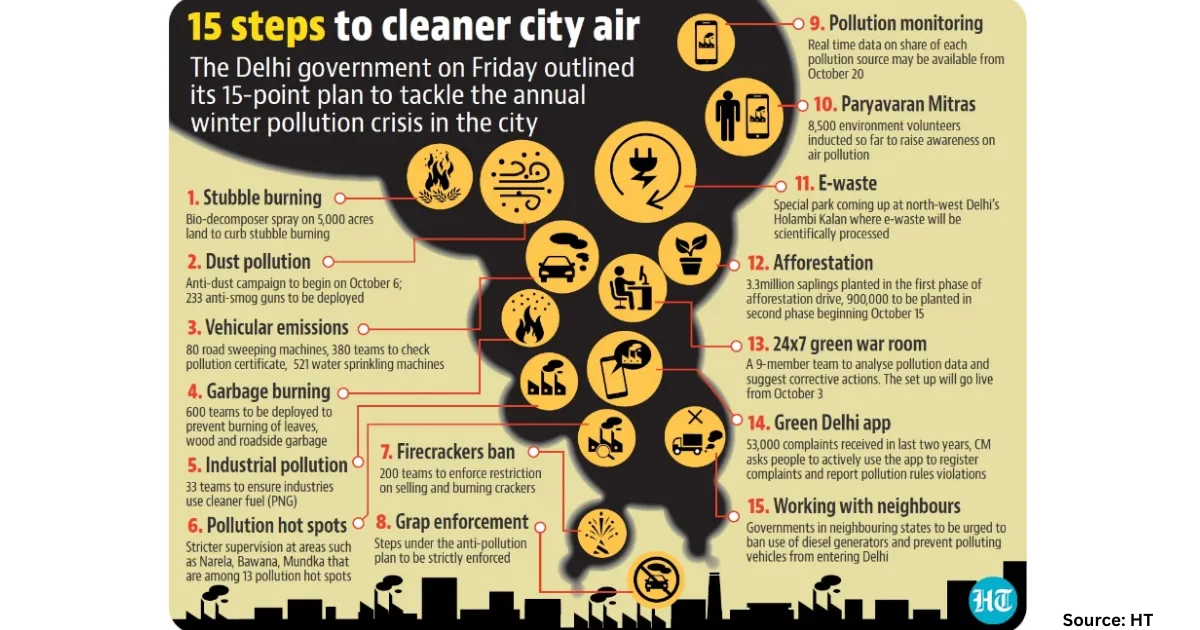
Air pollution in Delhi is a major environmental and health concern. The city’s air quality is consistently among the worst in the world, and it is estimated that air pollution causes over 20,000 premature deaths in Delhi each year.
There are a number of factors that contribute to air pollution in Delhi
- Vehicular emissions: Vehicles are the largest source of air pollution in Delhi. The city has a large and growing number of vehicles, and many of them are old and poorly maintained.
- Industrial emissions: Industries are another major source of air pollution in Delhi. The city has a large number of industries, and many of them use outdated and polluting technologies.
- Dust from construction activities: Construction activities are a major source of dust, which can contain harmful pollutants such as PM2.5.
- Biomass burning: Biomass burning, such as the burning of wood and crop residues, is a major source of air pollution in rural areas of Delhi. This pollution can then be transported to the city.
The health effects of air pollution in Delhi are wide-ranging and can be serious. Air pollution can cause respiratory problems, heart disease, lung cancer, and other health problems. It can also exacerbate existing health conditions such as asthma.
The Delhi government has taken a number of steps to tackle air pollution in the city
- Implementing the Graded Response Action Plan (GRAP)
- The GRAP is a set of anti-pollution measures that are implemented based on the severity of air pollution levels.
- These measures include restrictions on vehicle use, the closure of industries, and the spraying of water on roads.
- Promoting public transportation
- The government is promoting the use of public transportation by making it more affordable and accessible.
- This includes increasing the number of buses and metro trains, and making them more frequent and reliable.
- Investing in renewable energy
- The government is investing in renewable energy sources, such as solar and wind power, to reduce reliance on fossil fuels.
- This includes providing subsidies for renewable energy installations and setting targets for renewable energy generation.
- Controlling dust from construction sites
- The government has implemented a number of measures to control dust from construction sites, including requiring construction sites to be covered with tarps, and regularly spraying water on construction sites.
- Ban on open burning of waste
- The government has banned the open burning of waste, and is working to enforce this ban.
- This includes providing alternative waste disposal options, such as composting and incineration.
- Ban on firecrackers
- The government has banned the sale and use of firecrackers, which are a major source of air pollution during Diwali.
- Tree plantation
- The government is planting trees to help improve air quality.
- Trees absorb carbon dioxide, which is a major pollutant, and they also release oxygen.
The Delhi Pollution Control Committee (DPCC) is a regulatory body that implements environmental and pollution control laws.
Some things that individuals can do to reduce pollution include
- Driving less
- Keeping cars in good repair
- Turning off engines
- Not burning garbage
- Planting and caring for trees
- Using less energy
- Wearing a good-quality N95 mask
- Limiting outdoor activities to the afternoon
- Avoiding outdoor work or exercise during early morning and late evening hours

The Parali Pradushan Action Plan (PPAP)
It is a seven-point plan announced by the Delhi government in September 2019 to combat air pollution in the city. The plan focuses on reducing emissions from crop burning, which is a major contributor to air pollution in Delhi during the winter months.
The plan consists of the following seven points
- Odd-Even scheme: The odd-even scheme, which restricts the movement of vehicles on alternate days based on the last digit of their registration number, was implemented from November 4 to November 15.
- Distribution of pollution masks: The Delhi government distributed pollution masks to all households in the city.
- Community Diwali laser show: The Delhi government organized a community Diwali laser show to discourage people from bursting firecrackers.
- Deployment of environment marshals: The Delhi government deployed environment marshals to monitor compliance with the plan and to educate the public about air pollution.
- Identification of hotspot areas: The Delhi government identified 12 hotspot areas where air pollution is particularly severe. Special measures were implemented in these areas to reduce emissions.
- Controlling dust pollution: The Delhi government took measures to control dust pollution, such as spraying water on roads and footpaths.
- Tree plantation: The Delhi government launched a tree plantation drive to increase the city’s green cover.
The PPAP was successful in reducing air pollution in Delhi during the 2019-20 winter season. The city’s Air Quality Index (AQI) fell by 25% during the implementation of the plan. However, air pollution remains a serious problem in the city, and the government is continuing to take steps to further improve air quality.
Anti-smog guns:
Anti-smog guns are devices that spray water into the air to settle dust and particulate matter. They are used in winter when there is low humidity and dust particles are unable to settle. Anti-smog guns are not a permanent solution.
Anti-smog guns are:
- Designed to convert water into a fine spray
- Connected to a water tank mounted onto a vehicle
- Use high-pressure propellers to create a fine spray with a droplet size of 50-100 microns
- Used locally when there is fire or construction and demolition dust
Some things to consider about anti-smog guns include:
- Health effects
- High water requirements
- Risk of poor water quality
- Cannot reduce exposure to fine or ultra-fine particles unless the nozzle size is finer
The CPCB has made it mandatory to install anti-smog guns at all construction sites. Sites with an area of 10,001-15,000sqm should install two anti-smog guns, while three such machines are needed if the project is even larger (15,001-20,000sqm).
The odd-even scheme
The odd-even scheme is a car rationing scheme that allows cars to operate on alternate days based on their odd or even number plates. The scheme was introduced in 2016 to control vehicular pollution.
The scheme is intended to:
- Reduce the number of cars on the road
- Increase the use of public transportation
- Control air pollution
- Reduce particulate matter
The scheme works as follows:
- Cars with odd-numbered registration plates can drive on odd dates
- Cars with even-numbered registration plates can drive on even dates
The Delhi government has used the scheme four times. The government recently postponed the implementation of the scheme due to an improvement in air quality.
Conclusion
Combined action of the people and the government should be towards the common objective of pollution reduction keeping the practicality in mind.
 Chinmaya IAS Academy – Current Affairs Chinmaya IAS Academy – Current Affairs
Chinmaya IAS Academy – Current Affairs Chinmaya IAS Academy – Current Affairs